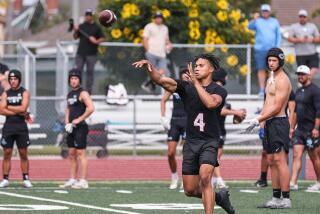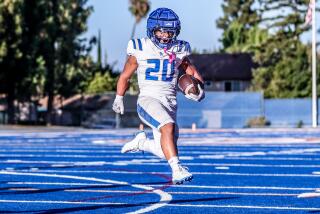Rivals Put Conejo’s Rule Into Practice
- Share via
At Southern Section schools Valley-wide, football teams are using every advantage they can find to get a jump on the competition. For many teams, this week’s athletic agenda includes everything from running a few plays and a few laps to team physicals and physical conditioning.
Over the hill and not too far away, teams in the Conejo Valley are taking time off. While other players are working up a sweat, teams from Thousand Oaks, Newbury Park and Westlake Village aren’t working at all. At least, that is, not under the watchful eye of coaches.
A policy adopted last year by the Conejo Valley Unified School District prohibits students involved in sports and other activities for class credit--such as drama or music--from supervision by teachers or coaches for four weeks during the summer. While Southern Section schools and other Marmonte League opponents such as Simi Valley, Camarillo and Channel Islands currently can conduct informal practices without pads and work out as a team, Conejo players must train on their own.
Southern Section teams may officially start two-a-day practices Monday and full-contact practices with pads Aug. 27.
Conejo coaches, understandably, would like to ensure that players stay in shape, especially with the start of the season so near. Visions of players and their revised workouts--sitting at home contemplating the harmonic convergence, eating seven-course meals consisting of a six-pack of Jolt Cola and a thick-crust pepperoni pizza--have Conejo coaches concerned.
“Where we’d normally be supervising the players and their training procedures, we now have to let them work out on their own,” Westlake Coach George Contreras said. “They can’t use our weight room and we can’t be in any kind of contact with them. No contact means no contact. We have to trust the players.”
The hands-off policy at the three Conejo schools has coaches wringing their hands. Lost time at this stage of the summer is hard to make up, Contreras said.
“We could really use the time in the weight room,” he said. “The loss of strength will put us at a disadvantage. The kids can’t believe they’re being told not to go that extra yard. It’s the fiasco I expected it to be.”
The policy was unanimously adopted in May, 1986, after the school board reportedly received complaints from parents who contended that coaches were requiring too much time from students. The edict--under which fall sports such as football and girls volleyball can split the four-week break into a pair of two-week periods--first was enforced this year.
Some schools outside the district are taking advantage of the opportunity to pick up ground on their idle league opponents. Royal currently is practicing and Simi Valley, which took this week off, practiced last week.
Conejo schools are not scheduled to resume practice until Monday.
“I really don’t think it puts any of our schools to a disadvantage,” said Ellyn Wilkins, a member of the Conejo school board. “We really haven’t heard any complaints, except from a few of the more vocal coaches. The parents are still behind the idea.”
Some coaches also have supported the idea.
“I think, in theory, that it’s a good idea,” said Coach Dave Murphy of Simi Valley, which isn’t subject to the rule. “But if you’re going to have a mandatory dead period, I think it would be better if it was systemwide, throughout the whole CIF.
“I think their board is putting kids in a position where they could suffer an injury from the layoff--a kid can lose a lot in a couple of weeks, especially going up against players who have been lifting.”
Wilkins, whose daughter Ellyn attends school in the district, said the parents long have complained that summer workouts have deprived families of vacations and time together. She insisted that if an athlete wants to train, facilities are available.
“My daughter swims 75 laps a day,” Wilkins said. “She can find a place to work out when she wants to work out. These kids are serious athletes. The ones that want to play aren’t going to come back as wimps. They’ll find somewhere to train.
“We just want them to have the opportunity to do other things with their families or whatever,” she said. “I want these kids to have the chance to be kids during their four years here. We think we have our priorities straight.”
Wilkins said she believes the policy is one of a kind.
“I’m not proud of the fact it’s unique,” she said. “I’m disappointed that it’s unique.”
Westlake’s first two-week dead period ran from late June into early July. The team then participated in summer passing leagues for five weeks before starting phase two last week.
Contreras said that time away from football isn’t something he finds objectionable. He just doesn’t like the ground rules.
“We usually take some time off this time of year,” he said. “But we always had the weight room open to the players. I’m just worried that they’ll have to use a private facility--and that can be pretty expensive--if they work out at all. Some will, some won’t.
“Let’s face it, it’s not much fun to run laps by yourself. Studies have shown that you start to lose strength 48 hours after a workout. I guess we’ll find out how much this hurts when we give players the conditioning tests next week.”
And if you can’t beat them, well. . . . Thousand Oaks Coach Bob Richards and Newbury Park Coach Ken Cook took advantage of the free time--both took a vacation last week.
And they’re off: City Section schools, which normally begin the regular season a week after the Southern Section, will start two weeks later this year, on Sept. 25. City practices begin Sept. 8, with full-contact practice scheduled for the following day.
Players attending City schools may take part in physical conditioning under a coach’s supervision for 20 hours this month.
Newswire: Chris Jones, a three-year starter at wide receiver for Reseda High from 1982-84, was shot and killed in Southwest Los Angeles last weekend, the Los Angeles coroner’s office confirmed.
Jones, 20, was pronounced dead at Daniel Freeman Hospital on Saturday evening at 9:44. He died of gunshot wounds to the head, according to a coroner’s office spokesman.
“Chris was just talking to me about getting a kid out of the neighborhood and getting him involved in our football program,” Reseda Coach Joel Schaeffer said. “It’s kind of ironic.”
Two out of three is bad: Out of the corner of his experienced eye, Canyon Coach Harry Welch spied something at Tuesday’s practice that he’d hoped not to see.
“Oh, no,” Welch said with a groan. “You see that guy right there? You see what’s on his hand? That’s my quarterback.”
Rod Baltau, a 6-2 junior projected to fill the position left by June graduate Ken Sollom, arrived with his right hand in a cast. Baltau broke the knuckle of his index finger Monday in a pass-rush simulation drill.
“I hit a lineman right in the head as I was following through,” Baltau said. “I found out it was broken this morning.”
Welch, who hadn’t been apprised of the physician’s report, had been hoping for the best. Baltau will be lost for at least four weeks and may miss the season opener against rival Hart on Sept. 11.
Welch now has a collection of question marks at the position. Jared Henderson, a 5-9 senior whom Welch called his best defensive back and wide receiver, apparently quit the team Monday. Henderson was the team’s third-string quarterback.
Said Welch: “He’s the best skilled player on our team, but he didn’t want to make the commitment to play Cowboy football.”
Second-string quarterback Rick Gambos, a 5-10 junior, will fill in for Baltau.
Adding to Canyon’s injury list was tight end Ken Holsenbeck, who required nine stitches in his head after being cut in a workout.
The cruelest cut: After a 3-1 start in 1986, Rio Mesa High’s football season burst right around the time Charlie Craig’s appendix threatened to do the same.
Craig, now a senior and fully recovered from surgery, missed the final seven games of his junior year as a scheduled starter at offensive tackle.
Without Craig, the Spartans finished the season 4-6 overall and sixth in the eight-team Channel League at 2-5. Rio Mesa was the defending league co-champion.
Rio Mesa Coach John Reardon doesn’t attribute the Spartans’ collapse entirely to Craig’s ailment--there were other injuries to the offensive and defensive lines--but that was one in particular he couldn’t stomach.
Craig is listed on Rio Mesa’s 1986 roster at 6-5, 212 pounds. According to Reardon, Craig is still 6-5 but now weighs 240 and also may play on the defensive line.
“Charlie’s a possible major-college player because of his size,” Reardon said.
Staff writers Mike Hiserman and Tim Brown contributed to this story.
More to Read
Get our high school sports newsletter
Prep Rally is devoted to the SoCal high school sports experience, bringing you scores, stories and a behind-the-scenes look at what makes prep sports so popular.
You may occasionally receive promotional content from the Los Angeles Times.






